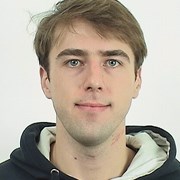CCS (Carbon Capture and Storage) is a solution with great potential to reduce CO2 emissions, which scientists at SINTEF began developing in the early 1980s. It involves capturing carbon dioxide (CO₂) and pumping it deep underground into natural, porous rock formations.
- You might also like to read: The summer that changed Norway’s climate policy
We take the CO₂ that we don’t want in the atmosphere and lock it away in a safe space. That place is in the ocean depths under several layers of rock, a strategy that Norway is now scaling up by leveraging its offshore expertise in the production and transport of hydrocarbons. The aim is to prevent CO₂ from being released into the atmosphere, and thus protect our climate for many hundreds of years to come.

Researcher and project manager Serhii Lozovyi: “Here I am in the lab with our innovation in hand.” Photo: SINTEF
Imaging the Earth’s interior
When CO₂ is stored in underground reservoirs, it is important to carry out continuous monitoring to ensure that everything is going as planned. The operators use seismic monitoring, much like a medical ultrasound – but for the Earth’s crust.
In short, weak vibration waves are sent down into the Earth and measured as they spread through the rock. Because waves propagate differently in rock saturated with different fluids, geophysicists can detect changes by repeating and comparing such measurements over time.
These changes could indicate that one fluid has displaced another. This seismic method makes it possible to monitor where CO₂ is located and how it spreads, contributing to more efficient injection planning – and at the same time preventing leaks.

Graphical representation of changes in seismic waves with changed gas saturation. The method is used to predict leaks of CO2 in the subsurface. Figure: SINTEF
Lab experiments on rock cores: small samples, big insights
Before these monitoring techniques are used in the field, researchers conduct extensive laboratory experiments with rock cores taken from relevant storage sites. This allows us to simulate underground conditions in a controlled environment, to study how CO₂ affects rock properties and how seismic waves change during different phases of CO₂ injection and migration.
Just as a scale model of a bridge is tested before it is built, these laboratory experiments help researchers interpret seismic data from real reservoirs with greater precision.

A sandstone sample mounted for testing at SINTEF’s Formation Physics Laboratory. Photo: SINTEF
Our unique CT low-frequency cell
One of the innovations in this field is SINTEF’s low-frequency pressure cell at the Formation Physics Laboratory. This device, which Kim S. Mews, a PhD research fellow at NTNU, and I have developed, is designed to measure rock properties at lower wave frequencies.
This is the same frequency range that is used in actual seismic surveys and is different from what is commonly used in traditional high-frequency ultrasound measurements in the lab.
While high-frequency ultrasound testing uses waves with wavelengths in the millimetre range, our low-frequency cell can expose the sample to waves on the 100-meter to kilometre scale. It therefore takes into account the physical mechanisms that actually exist in the field.

CT scan of a sandstone sample saturated with different amounts of water and gas. Photo: SINTEF
But we have managed to achieve even more: Our low-frequency cell is also designed to operate in an X-ray-based computed tomography (CT) scanner.
This feature provides us with CT images and a unique insight into the rock sample. Much as a medical scan reveals the inside of the body, we can now link seismic response and the actual imaged saturation and distribution of fluids in the rock being tested.
This combination of low-frequency measurements with CT images makes it possible to develop better models for rock physics. Such well-tailored models make it possible not only to locate CO2 in the subsurface, but also to quantify the amounts, which gives us better control over large-scale CO₂ storage.

PhD research fellow Kim S. Mews works on a sample setup. Photo: SINTEF
Results in safer storage of greenhouse gases
By using advanced laboratory techniques such as our CT low-frequency cell, technologists can now use small rock samples to improve our understanding of underground CO₂ storage. The insights this gives us open the door to safer and more efficient carbon storage, a critical component of the solution to slowing climate change.
Through careful monitoring and ground-breaking experiments, scientists can turn the Earth’s deep layers into a reliable ally in the fight against global warming. This work gives us hope – and a basis for a more sustainable future for us all.
Scientific reference:
The work was carried out through the PETROMAKS 2 research project “Calibrated rock physics model for quantitative seismic analysis of two-phase fluid saturation” (301910). The author would like to thank everyone who has contributed to the project. Their efforts and support have been invaluable.


